I’ve been tackling SoCal’s Angeles Crest Highway’s 66 miles of tarmac for as long as I can remember, but a recent ride aboard Honda’s 2020 CRF450L revealed another side of this rugged terrain—specifically, a trail that diverts from the hallowed highway and dives into the massive expanse of the Angeles National Forest. Welcome to dual sport life.
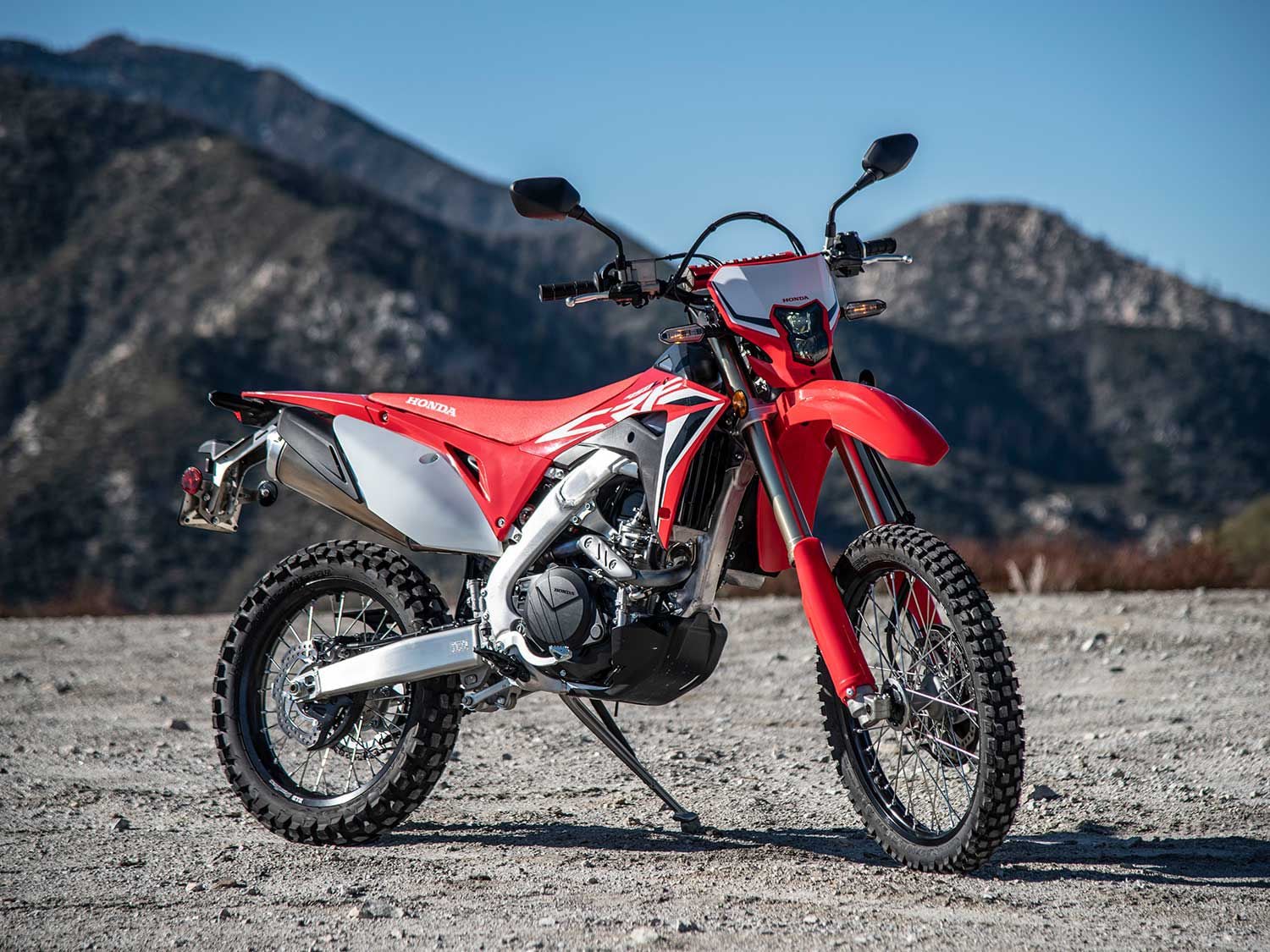
What looks alien on the road is right at home in the wilderness; the CRF’s ruggedness suits the expanses of California’s Angeles National Forest. (Basem Wasef/)
Honda’s CRF450L—the 450 represents the 449cc displacement and the L refers to electric start—was updated for the 2019 model year, holding the line on hardware but gaining bold new graphics for ’20. In case you’re not familiar with how this dual-purpose sled fits into the Honda lineup, here’s the lowdown: Unlike the competition-ready CRF450R ($9,399) or the ultra competition-ready CRF450WE ($11,999), the CRF450L ($10,399) packs discreet LED headlamps, turn signals, and brake lights that allow street-legal operation, as well as the obligatory rear license plate, of course. Differences between the pure dirt MX versions include Dunlop Geomax MX3S rubber on the R and IRC GP knobbies on the L, slightly modified off-road suspension calibration, and up to 12 percent more crank inertia on the L to smooth power delivery at low rpm. The street-ready version also gets a slightly larger titanium fuel tank (2 gallons, versus a piddling 1.7 gallons), which contributes to its 42-pound-heavier curb weight and total mass of 289 pounds—still a lightweight in this age of bloated bikes.
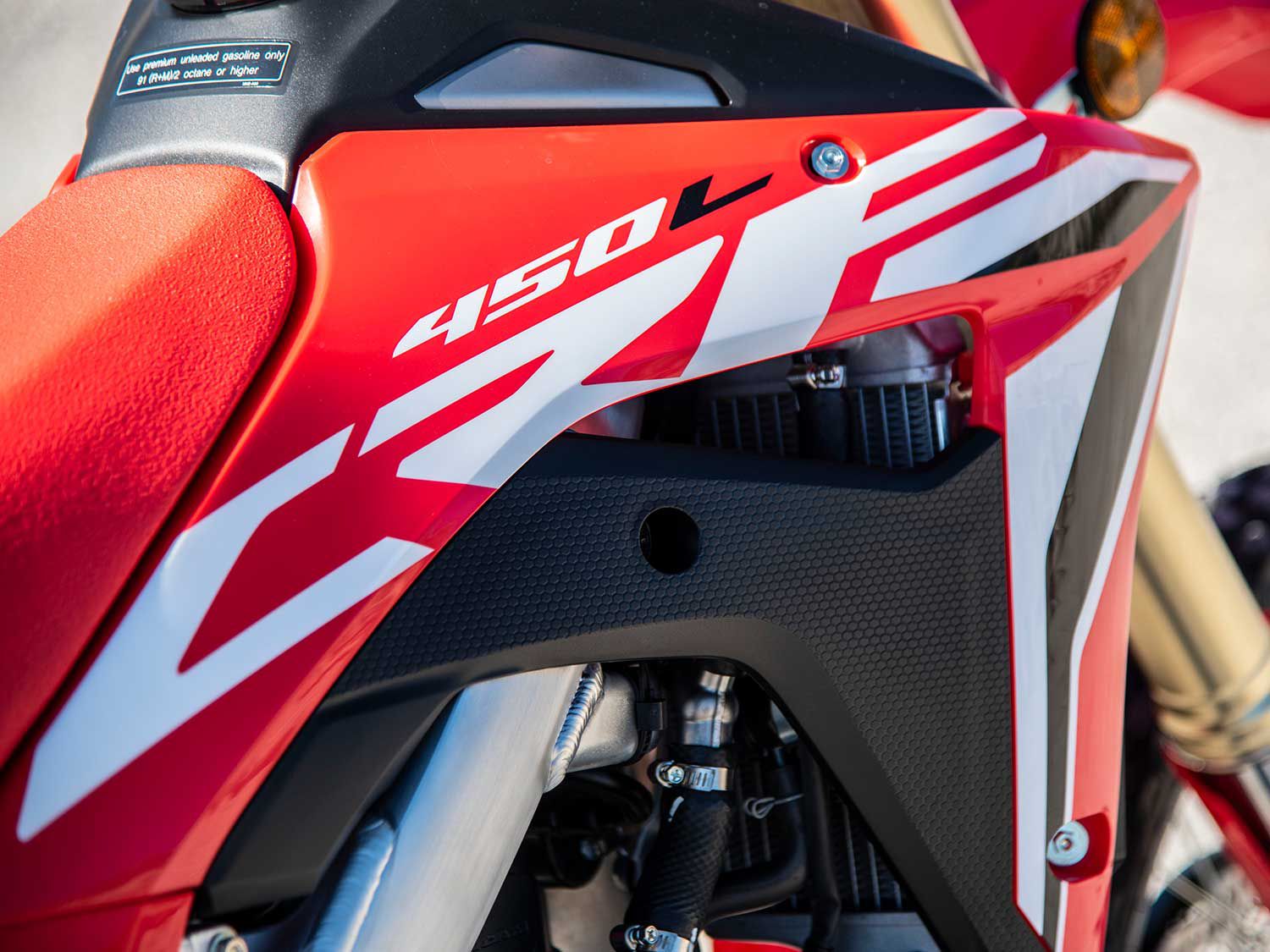
Don’t let the plastic cladding fool you: This Honda packs a titanium fuel tank for ultimate lightweighting. (Basem Wasef/)
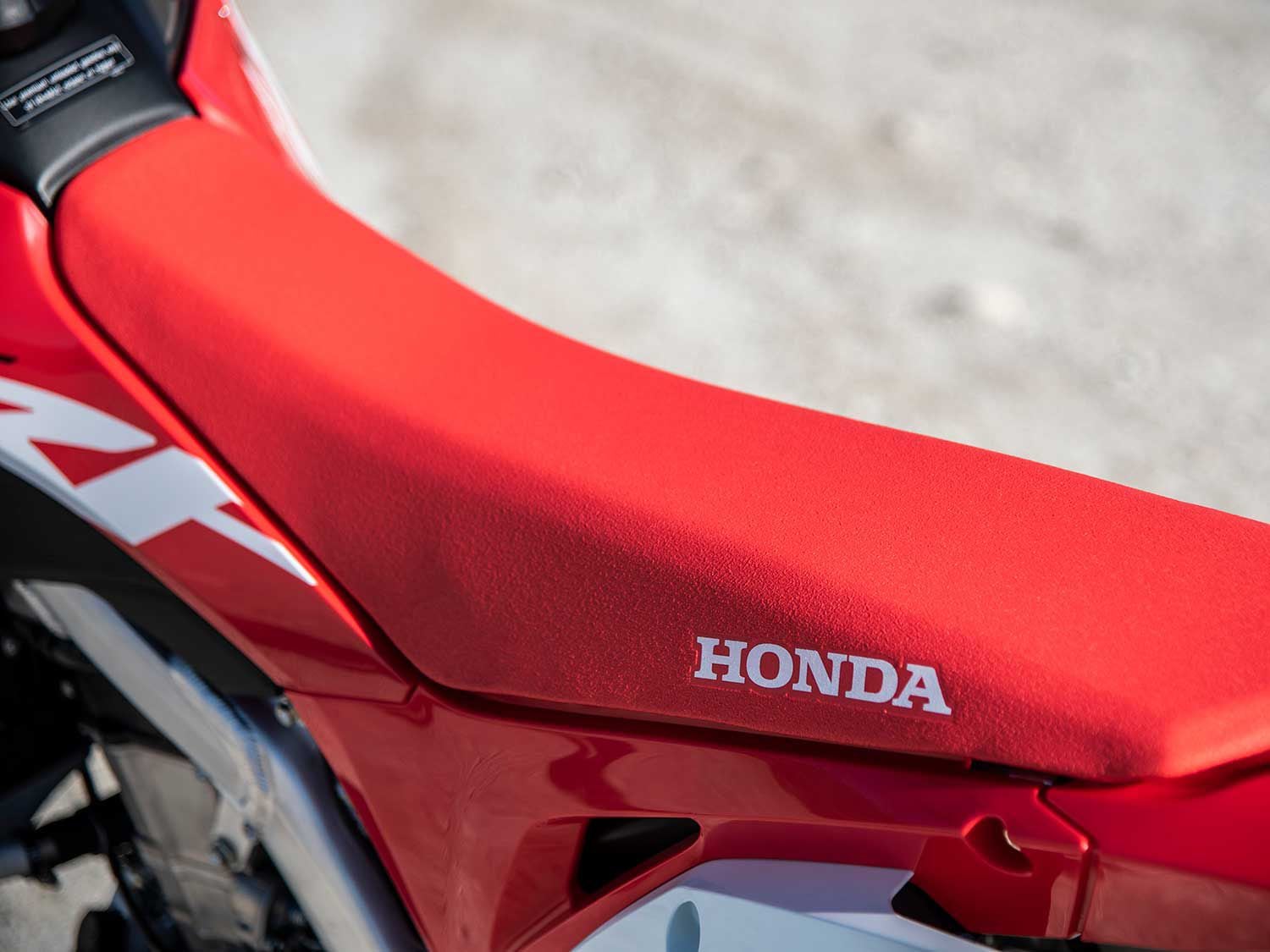
Don’t expect all-day comfort from the narrow saddle; the 450L is an off-roader first and a road bike second. (Basem Wasef/)
The added poundage probably won’t occur to you while riding the CRF450L on the road, as its sub-300-pound curb weight makes it an extreme lightweight in the face of porkier dual-purpose rides. Credit goodies like a titanium fuel tank and a lithium-ion battery for the featherweight footprint, which looks the part when perched atop the rigid, red saddle. It takes a bit of a leg swing to mount the bike, whose seat sits at a lofty 37.1 inches above ground. But once aboard, the altitude is not so alienating, due to the saddle’s thin contours and suspension softness; despite my 32-inch inseam, I’m able to stand on the balls of my feet at stoplights. Those of shorter stature might need to rest on one side only when not in motion.
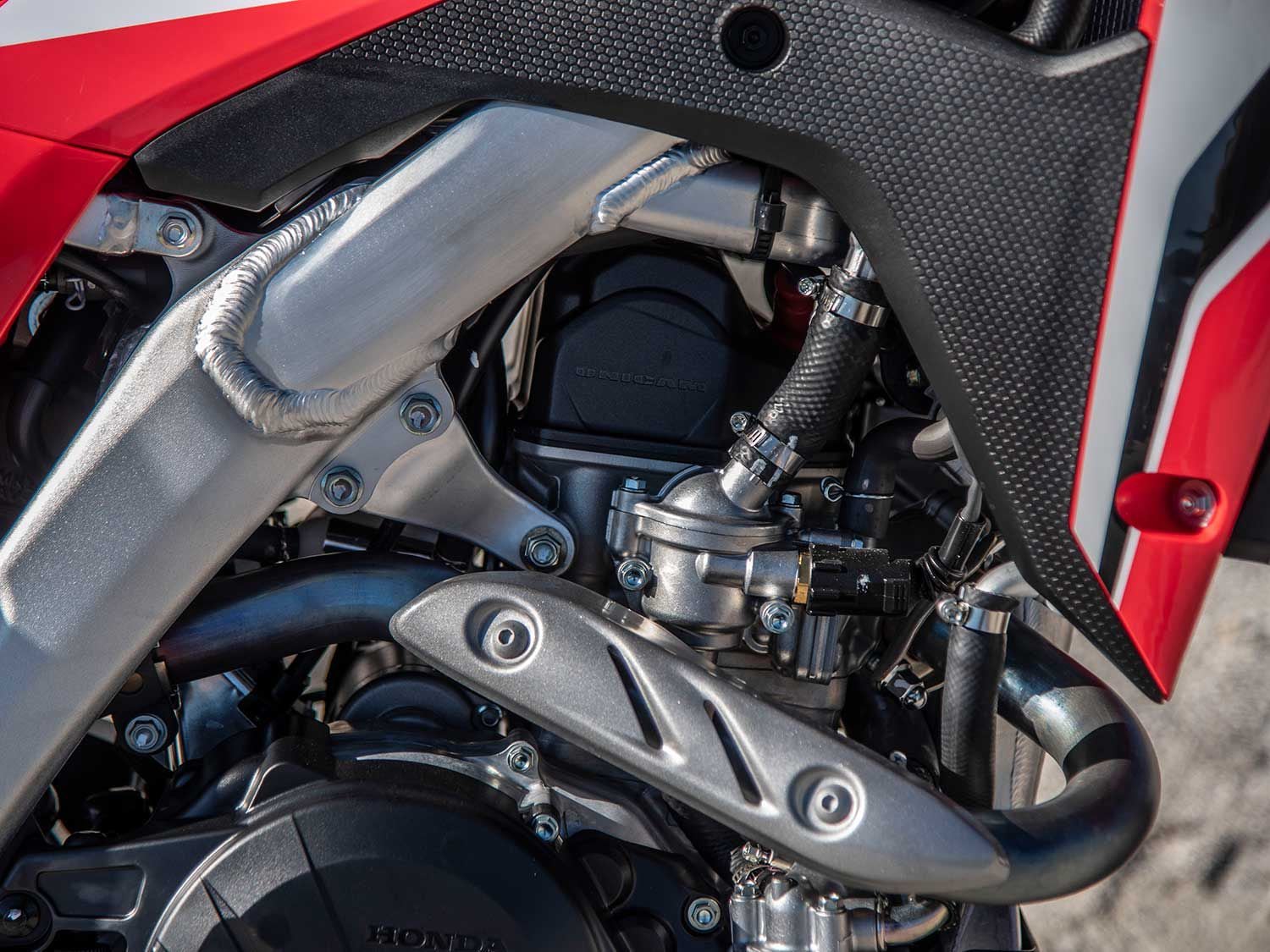
The 449cc liquid-cooled single cylinder features a specific valve timing tune for smooth power delivery. (Basem Wasef/)
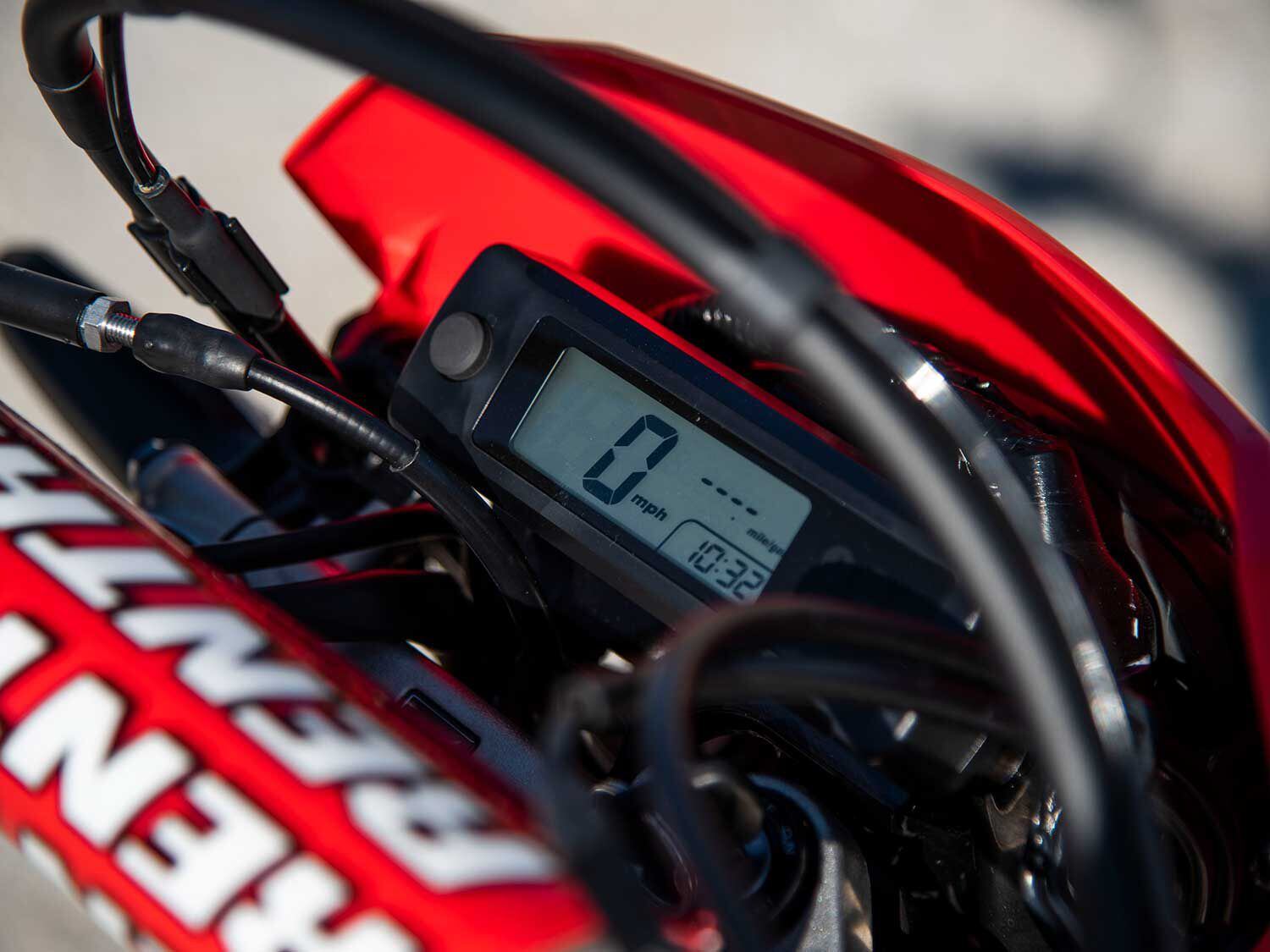
A tiny LCD screen betrays only the basics, though it does offer fuel economy and consumption figures. (Basem Wasef/)
Firing up the big single is an easy push-button affair, but cold-weather riders should note the fast idle knob, which acts like a choke would on a carbureted bike: When the climate is chilly you’ll need to twist the small control to keep the mill from dying at idle. Once warmed up, smooth off-the-line acceleration suffers requiring delicate throttle inputs, as the quick-revving single-cylinder engine tends to respond quickly, and sometimes suddenly, to grip twists in spite of the refinements made to the on-road version of the venerable CRF450R. Although instrumentation is minimal—all you get is a small LCD screen with a digital speedo and a few scrollable details like instant fuel economy and fuel consumed—the view over the padded Renthal handlebar is a stark reminder this bike is all about the seat of the pants, not information overload. There’s no traction control or ABS, and no numerical representation of where that big thumper is in the powerband, forcing you to choose your shift points the old-fashioned way: by listening to the motor and feeling the vibes through the pegs.
[IMG alt="<strong>Left:</strong> The CRF’s seemingly simple construction features outstanding attention to detail, including polished aluminum bits.
<strong>Right:</strong> Simple, functional details abound, including the knurled shifter pedal."]https://www.motorcyclistonline.com/...m/public/UH5WZHW7SJAFTIFOL7K4WJPPQQ.jpg[/IMG]
<strong>Left:</strong> The CRF’s seemingly simple construction features outstanding attention to detail, including polished aluminum bits. <strong>Right:</strong> Simple, functional details abound, including the knurled shifter pedal. (Basem Wasef/)
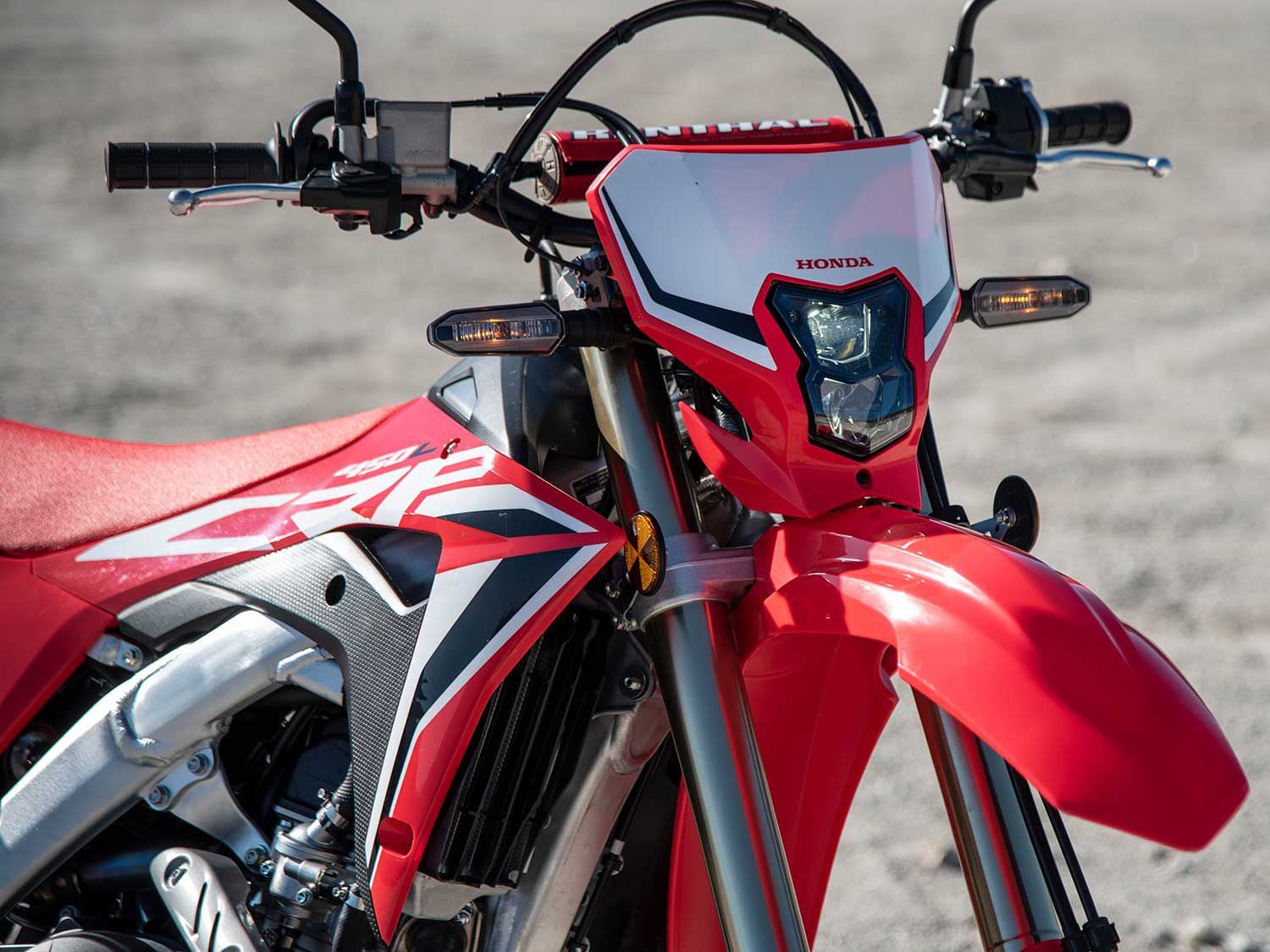
Tiny LED headlamps save space and weight, and discreet turn signals are a departure from Honda’s sometimes clunky parts-bin lighting solutions. (Basem Wasef/)
All of these factors make for an organic human/machine interface on the road. Clutch effort is light thanks to a damper mechanism that smooths out engine torque. Ride through city traffic, and your red and white off-roader feels decidedly different, especially since its street-legal concessions like headlamps and turn signals are diminutive and discreet. Keeping up with quick-moving traffic requires high revs and quick shifts, and the single-cylinder engine has to work hard to maintain pace with speedy four-wheelers. Exceed the rev range and the engine bounces at the limiter, begging for another shift—at least until you max out at around 90 mph. Cog swaps only need a very slight tap, and oftentimes don’t even require a grab of the clutch lever. Controls are harmonious and flow together nicely, from the precise, clicky feedback of the shifter to the fluidity of the steering and bike’s overall lightweight-but-solid construction. Although the front suspension delivers 12 inches of travel, there isn’t much, if any, dramatic nose-diving during hard braking. Incidentally, the L variant’s front discs are slightly thicker than the R’s and the reservoir slightly larger, in order to better cope with on-road braking demands.
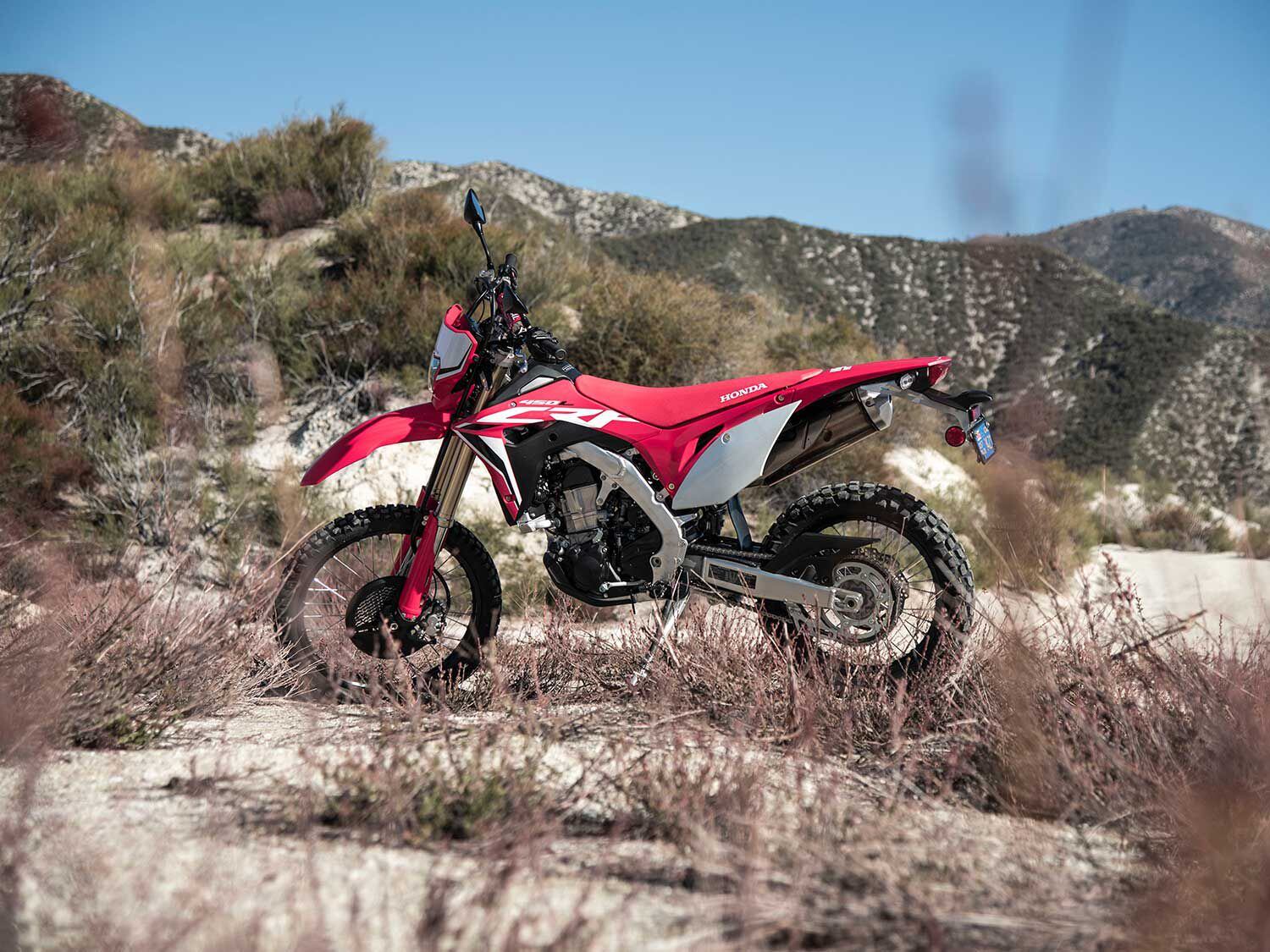
Mirrors fold back when riding through brush, making the CRF easily adaptable to rough terrain. (Basem Wasef/)

Cockpit view is reassuringly stripped down and simple, with the Renthal bar padded for good measure. (Basem Wasef/)
Along the familiar curves of Angeles Crest Highway, the CRF manages competence, but not necessarily breakneck speeds, extreme lean angles, or neck-bending acceleration. This is, after all, a dirt-focused motorcycle that happens to be street legal, not the other way around. But veering off the beaten path and exploring a fire trail opens up a whole new world, especially in the vastness of some 700,000 acres of wilderness. Suddenly the suspension, which seemed a bit soft on the road, is plush enough to soak up giant ruts and cracks in the earth. The engine, which felt somewhat anemic on pavement, now shreds the trail and shoots you forward as fast as you feel comfortable going—and sometimes, even faster. It’s dramatic, this shift from tarmac to trail, and exactly the kind of escape that shows you the transformative power motorcycling can hold.
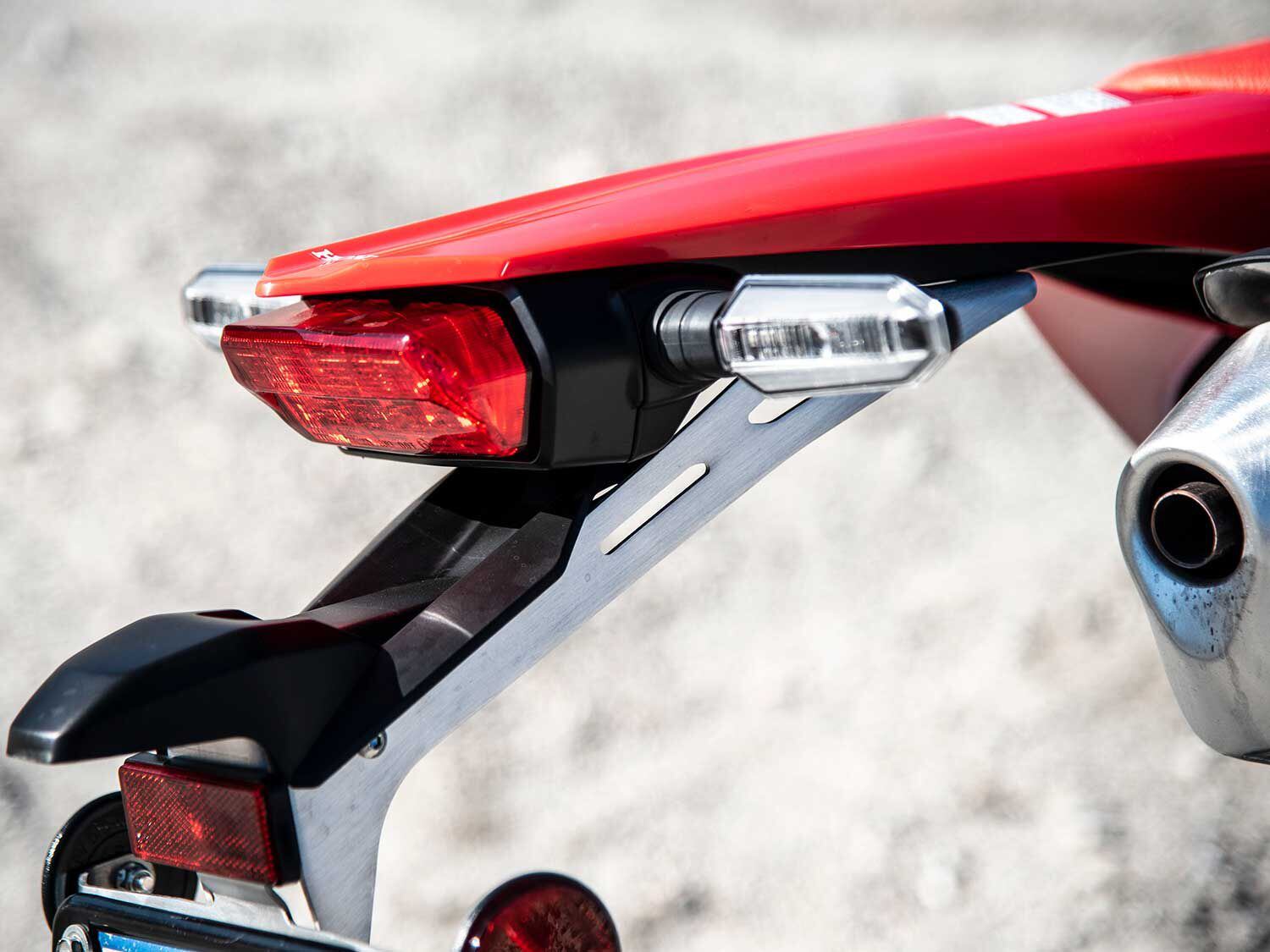
Stout construction graces the unlikeliest of components, including this aluminum license plate support piece, which could have easily been made of cheaper plastic material. (Basem Wasef/)
Sure, bigger-bore dual-purpose bikes have cushier seats and more potential for long-distance comfort. But if dicing through trails and slicing through cities is your thing, the race-bred CRF450L is a sharp, satisfying tool that opens up a world of on- and off-road adventure.
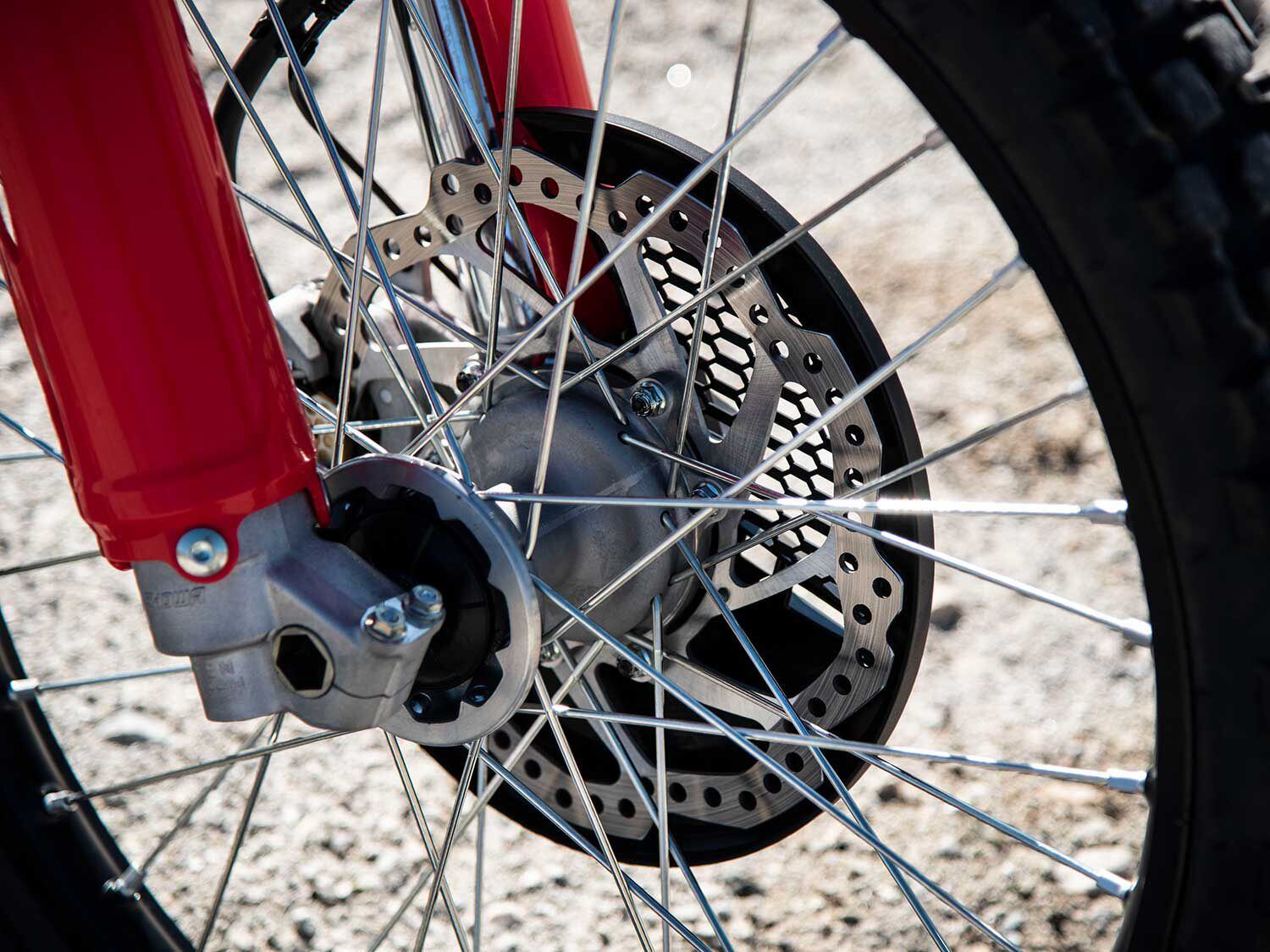
The L variant gets slightly thicker brake rotors and a larger fluid reservoir for increased fade resistance. (Basem Wasef/)
Gearbox
Helmet: AGV AX-8 EVO
Jacket: Aether Divide
Gloves: Dainese Full Metal RS
Pant: Aether Divide
Boots: Alpinestars Tech3
2020 Honda CRF450L Price And Specifications
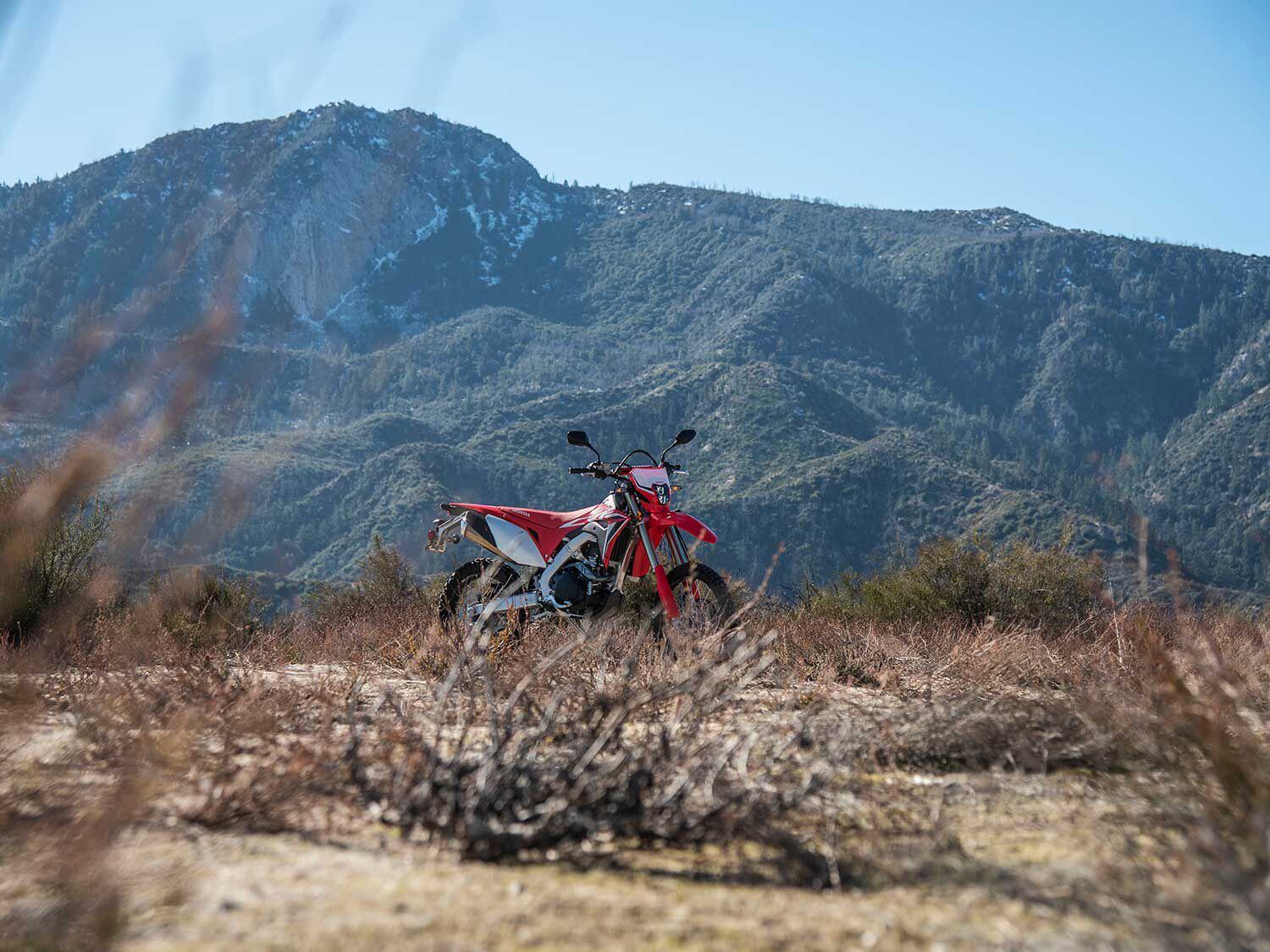
Getting lost in nature seems to be the CRF450L’s ultimate mission. (Basem Wasef/)
Continue reading...

What looks alien on the road is right at home in the wilderness; the CRF’s ruggedness suits the expanses of California’s Angeles National Forest. (Basem Wasef/)
Honda’s CRF450L—the 450 represents the 449cc displacement and the L refers to electric start—was updated for the 2019 model year, holding the line on hardware but gaining bold new graphics for ’20. In case you’re not familiar with how this dual-purpose sled fits into the Honda lineup, here’s the lowdown: Unlike the competition-ready CRF450R ($9,399) or the ultra competition-ready CRF450WE ($11,999), the CRF450L ($10,399) packs discreet LED headlamps, turn signals, and brake lights that allow street-legal operation, as well as the obligatory rear license plate, of course. Differences between the pure dirt MX versions include Dunlop Geomax MX3S rubber on the R and IRC GP knobbies on the L, slightly modified off-road suspension calibration, and up to 12 percent more crank inertia on the L to smooth power delivery at low rpm. The street-ready version also gets a slightly larger titanium fuel tank (2 gallons, versus a piddling 1.7 gallons), which contributes to its 42-pound-heavier curb weight and total mass of 289 pounds—still a lightweight in this age of bloated bikes.

Don’t let the plastic cladding fool you: This Honda packs a titanium fuel tank for ultimate lightweighting. (Basem Wasef/)

Don’t expect all-day comfort from the narrow saddle; the 450L is an off-roader first and a road bike second. (Basem Wasef/)
The added poundage probably won’t occur to you while riding the CRF450L on the road, as its sub-300-pound curb weight makes it an extreme lightweight in the face of porkier dual-purpose rides. Credit goodies like a titanium fuel tank and a lithium-ion battery for the featherweight footprint, which looks the part when perched atop the rigid, red saddle. It takes a bit of a leg swing to mount the bike, whose seat sits at a lofty 37.1 inches above ground. But once aboard, the altitude is not so alienating, due to the saddle’s thin contours and suspension softness; despite my 32-inch inseam, I’m able to stand on the balls of my feet at stoplights. Those of shorter stature might need to rest on one side only when not in motion.

The 449cc liquid-cooled single cylinder features a specific valve timing tune for smooth power delivery. (Basem Wasef/)

A tiny LCD screen betrays only the basics, though it does offer fuel economy and consumption figures. (Basem Wasef/)
Firing up the big single is an easy push-button affair, but cold-weather riders should note the fast idle knob, which acts like a choke would on a carbureted bike: When the climate is chilly you’ll need to twist the small control to keep the mill from dying at idle. Once warmed up, smooth off-the-line acceleration suffers requiring delicate throttle inputs, as the quick-revving single-cylinder engine tends to respond quickly, and sometimes suddenly, to grip twists in spite of the refinements made to the on-road version of the venerable CRF450R. Although instrumentation is minimal—all you get is a small LCD screen with a digital speedo and a few scrollable details like instant fuel economy and fuel consumed—the view over the padded Renthal handlebar is a stark reminder this bike is all about the seat of the pants, not information overload. There’s no traction control or ABS, and no numerical representation of where that big thumper is in the powerband, forcing you to choose your shift points the old-fashioned way: by listening to the motor and feeling the vibes through the pegs.
[IMG alt="<strong>Left:</strong> The CRF’s seemingly simple construction features outstanding attention to detail, including polished aluminum bits.
<strong>Right:</strong> Simple, functional details abound, including the knurled shifter pedal."]https://www.motorcyclistonline.com/...m/public/UH5WZHW7SJAFTIFOL7K4WJPPQQ.jpg[/IMG]
<strong>Left:</strong> The CRF’s seemingly simple construction features outstanding attention to detail, including polished aluminum bits. <strong>Right:</strong> Simple, functional details abound, including the knurled shifter pedal. (Basem Wasef/)

Tiny LED headlamps save space and weight, and discreet turn signals are a departure from Honda’s sometimes clunky parts-bin lighting solutions. (Basem Wasef/)
All of these factors make for an organic human/machine interface on the road. Clutch effort is light thanks to a damper mechanism that smooths out engine torque. Ride through city traffic, and your red and white off-roader feels decidedly different, especially since its street-legal concessions like headlamps and turn signals are diminutive and discreet. Keeping up with quick-moving traffic requires high revs and quick shifts, and the single-cylinder engine has to work hard to maintain pace with speedy four-wheelers. Exceed the rev range and the engine bounces at the limiter, begging for another shift—at least until you max out at around 90 mph. Cog swaps only need a very slight tap, and oftentimes don’t even require a grab of the clutch lever. Controls are harmonious and flow together nicely, from the precise, clicky feedback of the shifter to the fluidity of the steering and bike’s overall lightweight-but-solid construction. Although the front suspension delivers 12 inches of travel, there isn’t much, if any, dramatic nose-diving during hard braking. Incidentally, the L variant’s front discs are slightly thicker than the R’s and the reservoir slightly larger, in order to better cope with on-road braking demands.

Mirrors fold back when riding through brush, making the CRF easily adaptable to rough terrain. (Basem Wasef/)

Cockpit view is reassuringly stripped down and simple, with the Renthal bar padded for good measure. (Basem Wasef/)
Along the familiar curves of Angeles Crest Highway, the CRF manages competence, but not necessarily breakneck speeds, extreme lean angles, or neck-bending acceleration. This is, after all, a dirt-focused motorcycle that happens to be street legal, not the other way around. But veering off the beaten path and exploring a fire trail opens up a whole new world, especially in the vastness of some 700,000 acres of wilderness. Suddenly the suspension, which seemed a bit soft on the road, is plush enough to soak up giant ruts and cracks in the earth. The engine, which felt somewhat anemic on pavement, now shreds the trail and shoots you forward as fast as you feel comfortable going—and sometimes, even faster. It’s dramatic, this shift from tarmac to trail, and exactly the kind of escape that shows you the transformative power motorcycling can hold.

Stout construction graces the unlikeliest of components, including this aluminum license plate support piece, which could have easily been made of cheaper plastic material. (Basem Wasef/)
Sure, bigger-bore dual-purpose bikes have cushier seats and more potential for long-distance comfort. But if dicing through trails and slicing through cities is your thing, the race-bred CRF450L is a sharp, satisfying tool that opens up a world of on- and off-road adventure.

The L variant gets slightly thicker brake rotors and a larger fluid reservoir for increased fade resistance. (Basem Wasef/)
Gearbox
Helmet: AGV AX-8 EVO
Jacket: Aether Divide
Gloves: Dainese Full Metal RS
Pant: Aether Divide
Boots: Alpinestars Tech3
2020 Honda CRF450L Price And Specifications

Getting lost in nature seems to be the CRF450L’s ultimate mission. (Basem Wasef/)
| PRICE | $10,399 |
| MOTOR | 449cc, OHC, liquid-cooled single-cylinder four-stroke; 4-valve |
| BORE x STROKE | 96.0 x 62.1mm |
| COMPRESSION RATIO | 12.0:1 |
| FUEL DELIVERY | Programmed fuel injection, 46mm downdraft throttle body |
| CLUTCH | Wet, multiplate |
| TRANSMISSION/FINAL DRIVE | 6-speed/chain |
| FRAME | Twin-spar aluminum |
| FRONT SUSPENSION | 49mm inverted telescopic Showa fork adjustable for compression and rebound damping; 12.0-in. travel |
| REAR SUSPENSION | Fully adjustable Showa single shock; 12.4-in. travel |
| FRONT BRAKE | 2-piston caliper, 260mm disc |
| REAR BRAKE | 1-piston caliper, 240mm disc |
| WHEELS, FRONT/REAR | D.I.D DirtStar; 21.0-in. / 18.0-in. |
| TIRES, FRONT/REAR | IRC GP; 80/100-21 / 120/80-18 |
| RAKE/TRAIL | 28.0°/4.6 in. |
| WHEELBASE | 58.9 in. |
| SEAT HEIGHT | 37.1 in. |
| FUEL CAPACITY | 2.0 gal. |
| CLAIMED CURB WEIGHT | 289 lb. |
| WARRANTY | 1 year, unlimited mileage |
| AVAILABLE | Now |
Continue reading...

